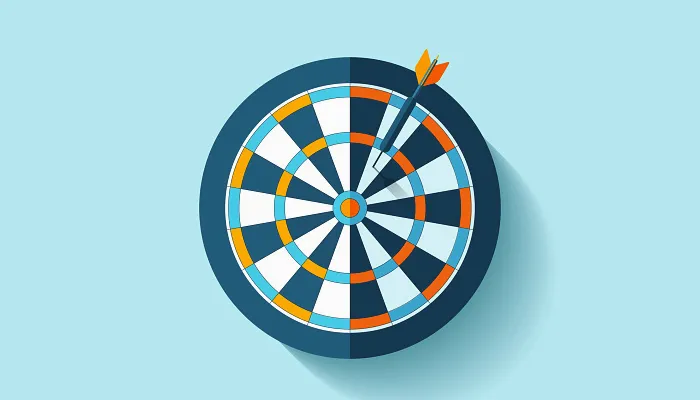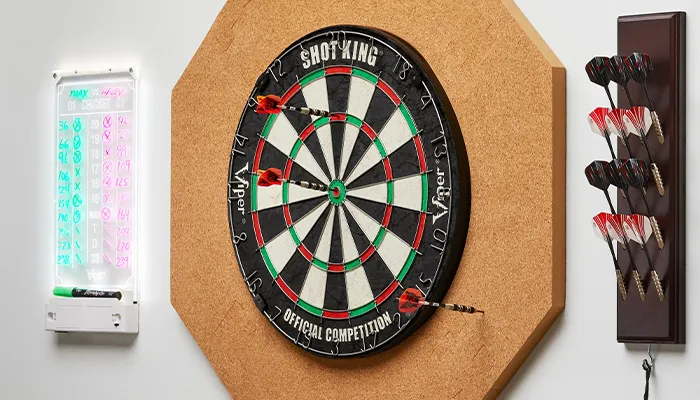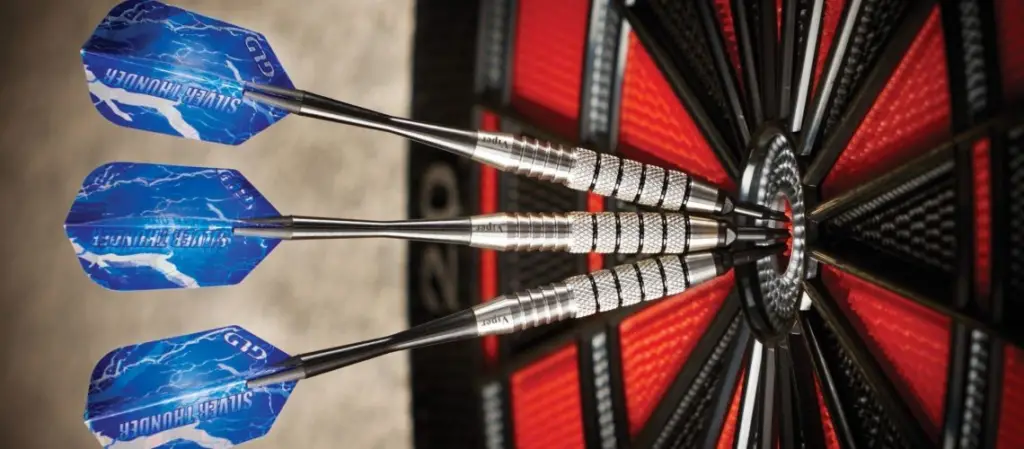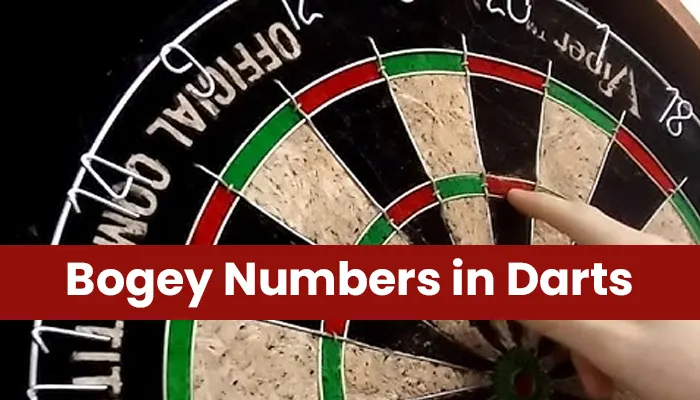You’ve been playing darts for a while now and are starting to get pretty good at it. You can consistently hit the big numbers like 20 and bullseye, and your accuracy is improving. Now you’re ready to up your game by aiming for bogey numbers.
Bogeys, as they’re called for short, refer to the trickier, smaller targets on the board that are harder to hit. Mastering bogeys is what separates the casual players from the pros.
To hit bogeys, you need a steady hand, sharp focus, and precise aim. But the rewards of nailing a bogey are high. Nothing feels better than seeing that dart stick right where you want it.
In this article, we’ll explore what bogey numbers are, why they matter, and tips to help you become a bogey-hitting machine.
Before you know it, you’ll be turning heads at the local pub as you confidently aim for and hit the bullseye of the bogey board. Game on!
What Is a Bogey Number in Darts?
A bogey number in darts refers to a score that is one dart shy of closing out an 01 game. For example, if you need 32 points to finish, a bogey would be hitting a single 16, leaving you with 16 points remaining (32 – 16 = 16).
Bogey numbers occur when you have an uneven combination of points left that doesn’t divide evenly by 3 darts. The most common bogeys in 01 games are 16, 8, and 4 points remaining. To hit these, you’ll want to aim for the triple or double segments to get as close as possible to closing out the game.
For 16 points, aim for the triple 8 (T8) segment. If you hit it, you’ll have 0 points left and win the game! If you hit a single 8 (S8), you’ll have 8 points remaining for a bogey. For 8 points left, shoot for the double 4 (D4) to end the game, or you’ll have a bogey of 4 points if you hit just a single 4 (S4). Finally, for 4 points aim small at the double 2 (D2) to win, or you’ll be left with just 2 points, the smallest possible bogey.
The key to hitting bogeys is precision. Take your time, focus on your target, and throw a smooth dart with a consistent release and follow through. With practice, your accuracy and consistency will improve, allowing you to hit those bogeys and ultimately, finish the game in style! Keep at it, focus on your fundamentals, and don’t get discouraged if you end up with a bogey. Even the pros struggle to close out a game at times. The important thing is you’re getting valuable experience playing the game you love!

How Bogey Numbers Are Calculated
To determine a bogey number, you first need to know the number of darts in a leg and the number of darts required to finish (which is usually 3). The bogey number is calculated by subtracting the finish number from the total darts, then dividing by 2.
For example, in a best of 5 leg (5 darts per leg), the finish requires 3 darts. So 5 – 3 is 2. Then 2 / 2 is 1. So the bogey number in a best of 5 leg is 1.
In a longer format, say a best of 7 leg (7 darts per leg), the math would be:
7 total darts – 3 darts to finish = 4 remaining darts
4 remaining darts / 2 = 2
So the bogey number in a best of 7 leg is 2.
The bogey number gives you an idea of the maximum number of darts you can afford to miss in a leg and still have a chance at winning. But keep in mind, the fewer darts you miss – the better! Work on precision and consistency to increase your odds of hitting the bogey number or better.
Some tips to help you achieve the bogey number:
•Focus on one dart at a time. Don’t think about the end result, just focus on executing each throw perfectly.
•A consistent pre-throw routine helps to keep you focused and aligned. Take your time.
•Use a balanced and level stance, hold the dart steadily and release smoothly.
•Aim small, miss small. Pick an exact spot on the board to aim at.
•Relax and believe in yourself! You’ve got this. With regular practice, hitting the bogey number can become second nature.

Why Bogey Numbers Matter in Darts
Bogey numbers represent the average number of darts needed to finish a leg of 501, the most common darts game. Knowing your bogeys can help you evaluate your performance and set goals to improve.
What’s Your Bogey Number?
To determine your bogey number, keep track of how many darts it takes you to finish a few legs of 501. Add up the total darts and divide by the number of legs. For a beginner, a bogey around 15 to 20 darts is common. As you get better, aim for bogeys under 15, or even under 10 darts for more advanced players.
Compare your bogeys to the professionals—the top players average around 5 to 7 darts to finish a leg. While you may never reach that level, lowering your bogey number shows you’re improving accuracy, finishing skills, and strategy.
Why Bogeys Matter
Knowing your bogeys gives you a concrete measure of your performance and a target to beat. If your current bogey is 18 darts, challenge yourself to lower it to 15 or less. Focus on finishing legs in fewer darts by improving skills like doubling out and maximizing your scoring opportunities.
Tracking your bogeys also allows you to evaluate the effectiveness of your practice. If you’ve been working on a new technique or strategy, see if your bogeys start to drop. This feedback will motivate you to continue improving.
In the end, becoming a better player comes down to consistently hitting lower bogey numbers. Keep practicing, analyze how you can finish legs more efficiently, and work to shave just one or two darts off your bogey. Over time, you’ll gain accuracy and confidence, and may even reach a bogey worthy of a pro.

Tips for Hitting Your Bogey Consistently
To hit your bogey number consistently in darts, focus on a few key tips:
Aim small, miss small
Don’t just throw at the board, pick a specific number or area you want to hit. Visualize the triple 20, double 12 or single 5—whatever your bogey number may be. When you aim for a smaller target, your darts are more likely to at least come close to where you want them.
Consistent stance and release
Stand the same way, hold the dart the same way and release the dart the same way every time. Any variation in your stance, grip or throw can cause your darts to go off course. Find what is comfortable and natural for you, and repeat it on every throw. Muscle memory will kick in, allowing you to release each dart the same way.
Follow through
A good follow through is key. Release the dart and continue the motion of your arm extended and pointed at the target. This helps ensure a straight and accurate throw. If your arm stops abruptly after releasing the dart, it can cause it to swerve off course. Finish with your arm extended and don’t drop your elbow.
Practice the bogey
The only way to truly get better at hitting a specific number is to practice throwing at that number. Spend time each practice session focused solely on your bogey number. Start close to the board and work your way back as your accuracy improves. Track your success as you practice and aim to increase your consistency over time.
With regular practice using these tips, your muscle memory will develop and confidence will grow. Stay focused, keep a consistent form and continue aiming for your bogey number. Before you know it, you’ll be hitting it more often than not!

Common Bogey Numbers for Different Dart Abilities
For beginner darts players, the most common bogey numbers are the larger, easier to hit areas of the board. As your skills improve, the bogeys get harder to hit.
20
The largest section on the board, the 20 is an easy target for new players. Aim for the middle or triple 20 to rack up points.
19
Just below the 20, the 19 is another area where beginners can find success. The triple 19 is also within reach.
18
On the outer edge of the board, the 18 provides a large surface for darts to land. Doubles and triples of 18 are good to aim at as your accuracy improves.
Bullseye (50)
Right in the center, the bullseye is a challenging bogey for beginners but rewarding when you hit it. Aim small, miss small.
Doubles (2-20)
As you advance to the intermediate level, doubles 2 through 20 become common bogeys. They provide a balance of challenge and opportunity for higher scores. Focus on the larger numbers at first, then work your way in.
Triples (3-20)
For more experienced players, the triple areas open up more chances for high scores. Triples 3 through 20, especially the larger numbers, are frequent bogeys for advanced intermediate and expert players.
The bogey numbers you aim for will depend on your current skill level and how much challenge you want to take on. Start with the larger, easier targets, then move on to the trickier shots as your accuracy and consistency improves. With regular practice, those bogeys will become second nature.
FAQs
When playing darts, you’re bound to hear about “bogey numbers.” But what exactly are they and why are they important? Here are some common questions about bogey numbers answered:
Conclusion
You may have heard the term ‘bogey number’ tossed around at your local dart bar and wondered what it meant. Now you know – it refers to hitting certain target scores that are challenging but achievable for a player of your skill level.
While hitting a bogey number during a match won’t win you the game outright, it gives you a mental boost and intimidates your opponent. With regular practice, those bogey numbers will start to seem not so scary after all.
So grab your darts, step up to the oche, focus on your target, and let it rip. Before you know it, you’ll be bragging to your friends about hitting that elusive double 20 or finishing on the bullseye. Keep at it and who knows – you may even start setting bogey numbers for the other players to aim for!


